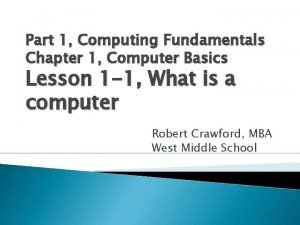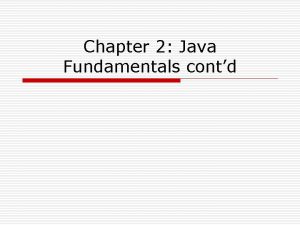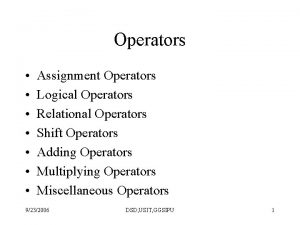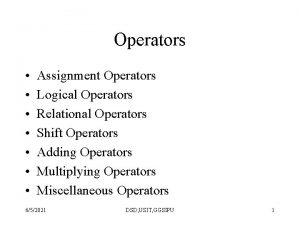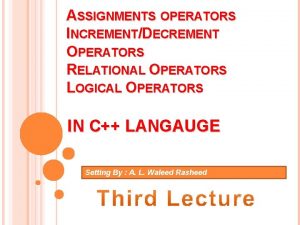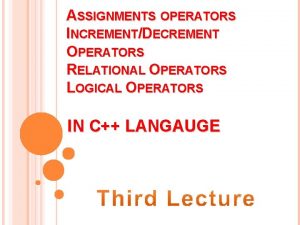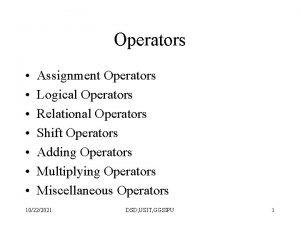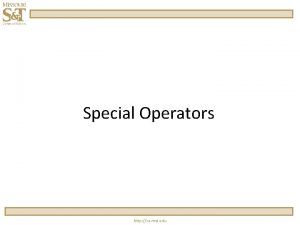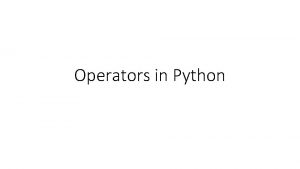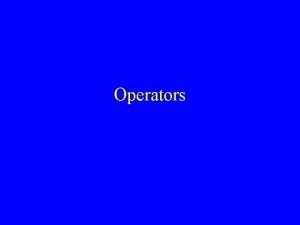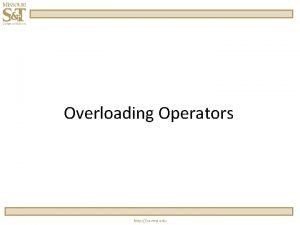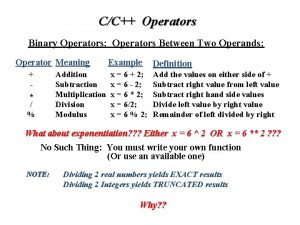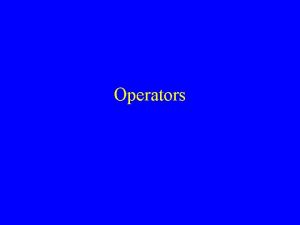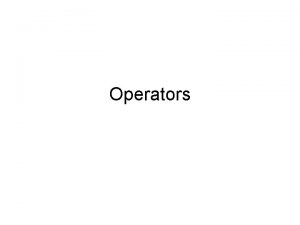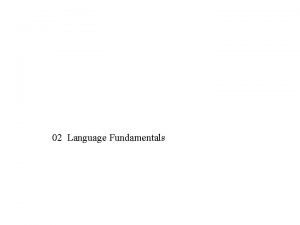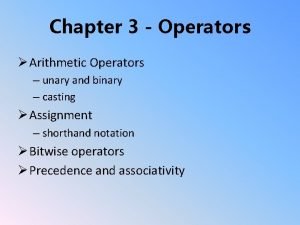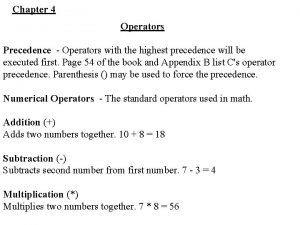FUNDAMENTALS 2 CHAPTER 2 OPERATORS Operators are special


























![import java. util. Scanner; public class Test. Input { EXAMPLE public static void main(String[] import java. util. Scanner; public class Test. Input { EXAMPLE public static void main(String[]](https://slidetodoc.com/presentation_image_h/246fbcb130fdb8b801d38c723f0eeb4c/image-27.jpg)






- Slides: 33

FUNDAMENTALS 2 CHAPTER 2

OPERATORS Operators are special symbols used for: mathematical functions assignment statements logical comparisons Examples of operators: 3 + 5 // uses + operator 14 + 5 – 4 * (5 – 3) // uses +, -, * operators Expressions: can be combinations of variables and operators that result in a value

GROUPS OF OPERATORS There are 5 different groups of operators: Arithmetic Operators Assignment Operator Increment / Decrement Operators Relational Operators Logical Operators

JAVA ARITHMETIC OPERATORS Addition + Subtraction – Multiplication Division / Remainder (modulus ) Assignment Operator = %

ARITHMETIC OPERATORS The following table summarizes the arithmetic operators available in Java.

EXAMPLE Example of division issues: 10 / 3 gives 3 10. 0 / 3 gives 3. 33333 As we can see, • if we divide two integers we get an integer result. • if one or both operands is a floating-point value we get a floating-point result.

MODULUS v. Generates the remainder when you divide two integer values. 5%3 gives 2 5%4 gives 1 5%5 gives 0 5%10 gives 5 v. Modulus operator is most commonly used with integer operands. If we attempt to use the modulus operator on floating-point values we will garbage!

EXAMPLE: SUM OF TWO INTEGER public class Sum { // main method public static void main( String args[] ){ int a, b, sum; a = 20; b = 10; sum = a + b; System. out. println(a + ” + b + “ = “ + sum); } // end main } // end class Sum

ARITHMETIC/ASSIGNMENT OPERATORS Java allows combining arithmetic and assignment operators into a single operator: Addition/assignment += Subtraction/assignment -= Multiplication/assignment = Division/assignment /= Remainder/assignment %=

INCREMENT/DECREMENT OPERATORS Only use ++ or when a variable is being incremented/decremented as a statement by itself. x++; is equivalent to x = x+1; x--; is equivalent to x = x-1;

RELATIONAL OPERATORS Relational operators compare two values They Produce a boolean value (true or false) depending on the relationship Operation Is true when a >b a is greater than b a >=b a is greater than or equal to b a ==b a is equal to b a !=b a is not equal to b a <=b a is less than or equal to b a <b a is less than b

EXAMPLE int x = 3; int y = 5; boolean result; result = (x > y); now result is assigned the value false because 3 is not greater than 5

LOGICAL OPERATORS Symbol Name && AND || OR ! NOT || T F && T F T T T F F F F

EXAMPLE boolean x = true; boolean y = false; boolean result; result = (x && y); result is assigned the value false result = ((x || y) && x); (x || y) evaluates to true (true && x) evaluates to true result is then assigned the value true

OPERATORS PRECEDENCE Parentheses (), inside-out Increment/decrement ++, --, from left to right Multiplicative *, /, %, from left to right Additive +, -, from left to right Relational <, >, <=, >=, from left to right Equality ==, !=, from left to right Logical AND && Logical OR || Assignment =, +=, -=, *=, /=, %=

INPUT & OUTPUT

INPUT AND SYSTEM. IN System. out An object with methods named println and print System. in not intended to be used directly We use a second object, from a class Scanner, to help us. Constructing a Scanner object to read console input: Scanner name = new Scanner(System. in); Example: Scanner console = new Scanner(System. in);

STANDARD OUTPUT WINDOW Using System. out, we can output multiple lines of text to the standard output window. • The exact style of standard output window depends on the Java tool you use.

THE PRINTLN METHOD We use println instead of print to skip a line. int x = 123, y = x + x; System. out. print( " x = “ ); System. out. println( x ); System. out. print( " x + x = “ ); System. out. println( y ); System. out. println( " THE END“ ); x = 123 x + x = 246 THE END

STANDARD INPUT To input primitive data values, we use the Scanner class. 4 steps are needed to be able to use input primitive: Step 1: import the Scanner class: import Java. util. Scanner; Step 2 : declaring a reference variable of a Scanner read ; //we named the object read Step 3: creating an instance of the Scanner read = new Scanner (System. in); Step 4: use specific methods to enter data int x = read. next. Int();

JAVA CLASS LIBRARIES, IMPORT Java class libraries: Classes included with Java's JDK. organized into groups named packages To use a package, put an import declaration in your program. Syntax: // put this at the very top of your program import package. Name. *; Scanner is in a package named java. util import java. util. *; import java. util. Scanner; To use Scanner, you must place the above line at the top of your program (before the public class header).

SCANNER METHODS Method next. Int() Description reads a token of user input as an int next. Double() reads a token of user input as a double next() reads a token of user input as a String next. Line() reads a line of user input as a String Each method waits until the user presses Enter. The value typed is returned. System. out. print("How old are you? "); int age = console. next. Int(); System. out. println("You'll be 40 in " + (40 - age) + " years. "); // prompt: A message telling the user what input to type.

COMMON SCANNER METHODS Method Example Scanner input = new Scanner (System. in); next. Byte( ) byte b = input. next. Byte( ); next. Double( ) double d = input. next. Double( ); next. Float( ) float f = input. next. Float( ); next. Int( ) int i = input. next. Int( ); next. Long( ) long l = input. next. Long( ); next. Short( ) short s = input. next. Short( ); next() String str = input. next();

EXAMPLE SCANNER USAGE import java. util. *; // so that I can use Scanner public class Read. Some. Input { public static void main(String[] args) { Scanner console = new Scanner(System. in); System. out. print("How old are you? "); int age = console. next. Int(); System. out. println(age + ". . . That's quite old!"); } } Output (user input underlined): How old are you? 14 14. . . That's quite old!

ANOTHER SCANNER EXAMPLE import java. util. *; // so that I can use Scanner public class Scanner. Sum { public static void main(String[] args) { Scanner console = new Scanner(System. in); System. out. print("Please type three numbers: "); int num 1 = console. next. Int(); int num 2 = console. next. Int(); int num 3 = console. next. Int(); int sum = num 1 + num 2 + num 3; System. out. println("The sum is " + sum); } } Output (user input underlined): Please type three numbers: 8 6 13 The sum is 27 The Scanner can read multiple values from one line.

INPUT TOKENS token: A unit of user input, as read by the Scanner. Tokens are separated by whitespace (spaces, tabs, newlines). How many tokens appear on the following line of input? 23 John Smith 42. 0 "Hello world" $2. 50 " 19" When a token is not the type you ask for, it crashes. System. out. print("What is your age? "); int age = console. next. Int(); Output: What is your age? Timmy java. util. Input. Mismatch. Exception at java. util. Scanner. next(Unknown Source) at java. util. Scanner. next. Int(Unknown Source). . .
![import java util Scanner public class Test Input EXAMPLE public static void mainString import java. util. Scanner; public class Test. Input { EXAMPLE public static void main(String[]](https://slidetodoc.com/presentation_image_h/246fbcb130fdb8b801d38c723f0eeb4c/image-27.jpg)
import java. util. Scanner; public class Test. Input { EXAMPLE public static void main(String[] args) { Scanner input ; int area , length, width; input = new Scanner (System. in); // creating an instance System. out. println("enter the length "); length = input. next. Int(); //reading the length from the keyboard System. out. println("Enter the Width "); width = input. next. Int(); //reading the width from the keyboard area = length * width ; System. out. println("the length is "+ length); System. out. println("the width is "+ width); System. out. println("the area is "+ area); } }

OUTPUT enter the length 2 Enter the Width 3 the length is 2 the width is 3 the area is 6

COMMONLY USED ESCAPE SEQUENCES 29

PARSING

PARSING NUMERIC STRINGS s s Integer, Float, and Double are classes designed to convert a numeric string into a number. These classes are called wrapper classes. s parse. Int is a method of the class Integer, which converts a numeric integer string into a value of the type int. s parse. Float is a method of the class Float and is used to convert a numeric decimal string into an equivalent value of the type float. s parse. Double is a method of the class Double, which is used to convert a numeric decimal string into an equivalent value of the type double. 31

PARSING NUMERIC STRINGS s A string consisting of only integers or decimal numbers is called a numeric string. s To convert a string consisting of an integer to a value of the type int, we use the following expression: Integer. parse. Int(str. Expression) • Example: Integer. parse. Int("6723") = 6723 Integer. parse. Int("-823") = -823 32

PARSING NUMERIC STRINGS s To convert a string consisting of a decimal number to a value of the type float, we use the following expression: Float. parse. Float(str. Expression) • Example: Float. parse. Float("34. 56") = 34. 56 Float. parse. Float("-542. 97") = -542. 97 s To convert a string consisting of a decimal number to a value of the type double, we use the following expression: Double. parse. Double(str. Expression) • Example: Double. parse. Double("345. 78") = 345. 78 Double. parse. Double("-782. 873") = -782. 873 33
 Mikael ferm
Mikael ferm Nursing chapter 1
Nursing chapter 1 Fundamentals of electric circuits chapter 4 solutions
Fundamentals of electric circuits chapter 4 solutions Fundamentals of corporate finance chapter 6 solutions
Fundamentals of corporate finance chapter 6 solutions Digital fundamentals chapter 4
Digital fundamentals chapter 4 Conceptual physics magnetism
Conceptual physics magnetism Tire wheel and wheel bearing fundamentals
Tire wheel and wheel bearing fundamentals Understanding your health and wellness chapter 1
Understanding your health and wellness chapter 1 9
9 Fundamentals of electric circuits chapter 7 solutions
Fundamentals of electric circuits chapter 7 solutions Building the right foundations/fundamentals
Building the right foundations/fundamentals Chapter 1 computer fundamentals
Chapter 1 computer fundamentals Examples of agency problems
Examples of agency problems Fundamentals of thermal-fluidsciences chapter 1 problem 13p
Fundamentals of thermal-fluidsciences chapter 1 problem 13p Principles of information systems
Principles of information systems Fundamentals of information systems chapter 1
Fundamentals of information systems chapter 1 Fundamentals of nursing chapter 17 vital signs
Fundamentals of nursing chapter 17 vital signs Chapter 6 fingerprints
Chapter 6 fingerprints Fundamentals in lodging operations chapter 2
Fundamentals in lodging operations chapter 2 Chapter 2 lab java fundamentals
Chapter 2 lab java fundamentals Fundamentals of nursing chapter 15 critical thinking
Fundamentals of nursing chapter 15 critical thinking Fundamentals of thermal-fluidsciences chapter 1 problem 9p
Fundamentals of thermal-fluidsciences chapter 1 problem 9p Chapter 39 electrical fundamentals
Chapter 39 electrical fundamentals Fundamentals of thermal-fluidsciences chapter 1 problem 19p
Fundamentals of thermal-fluidsciences chapter 1 problem 19p Fundamentals of thermal-fluidsciences chapter 2 problem 47p
Fundamentals of thermal-fluidsciences chapter 2 problem 47p Fundamentals of nursing chapter 15 critical thinking
Fundamentals of nursing chapter 15 critical thinking Glencoe health chapter 1 understanding health and wellness
Glencoe health chapter 1 understanding health and wellness Fundamentals of thermal-fluidsciences chapter 1 problem 19p
Fundamentals of thermal-fluidsciences chapter 1 problem 19p Fundamentals of thermal-fluidsciences chapter 1 problem 13p
Fundamentals of thermal-fluidsciences chapter 1 problem 13p Stress and adaptation fundamentals of nursing
Stress and adaptation fundamentals of nursing Grashoff number
Grashoff number Fundamentals of corporate finance, chapter 1
Fundamentals of corporate finance, chapter 1 Fundamentals of thermal-fluidsciences chapter 2 problem 30p
Fundamentals of thermal-fluidsciences chapter 2 problem 30p Fundamentals of thermal-fluidsciences chapter 2 problem 30p
Fundamentals of thermal-fluidsciences chapter 2 problem 30p











